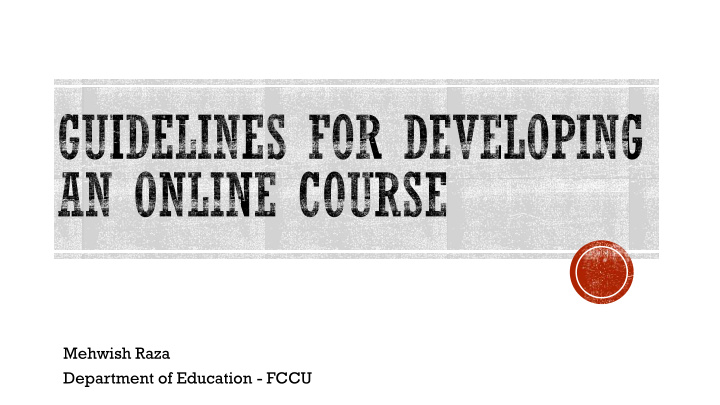



Mehwish Raza Department of Education - FCCU
Approaches of e-learning Types of e-learning content Creating interactive content Assessment in e-learning
Self-Paced e-Learning Product oriented learning Learners are offered e-learning courseware which is complemented by supplemental resources and assessment tasks. Learners are free to learn at their own pace and to define personal learning paths based on their individual needs and interests.
Instructor-led e-Learning A linear curriculum that integrates several content elements and activities into a chronological course or syllabus. The course is scheduled and led by an instructor and/or facilitator through an online learning platform. Supporting resources can be integrated with instructor’s lectures, individual assignments and collaborative activities among learners.
Simple learning resources Interactive e-lessons Electronic simulations Job aids
Synchronous Asynchronous Synchronous events take place in real time. Asynchronous events are time-independent. Synchronous communication between two A self-paced course is an example of people requires them to both be present at a asynchronous e-learning because online given time. learning takes place at any time. Chat • E-mail • • Video and audio conference • Discussion forum Live webcasting • Wiki • Application sharing • Blog • • Whiteboard Webcasting • Polling •
Expositive Methods Application Methods Collaborative Methods • Presentations • Demonstrations • Online guided discussion Case studies Practice Collaborative work • • • Worked examples Case-based exercises Peer tutoring • • • • Demonstrations • Role plays (creating situations) • Simulations and serious games Guided research Project • work
Learner- Granular Engaging centered Interactive Personalized
Deductive Sequencing: Theory is presented before an example or case and reflects a behavioral approach to emphasize response strengthening. Inductive Sequencing: Reflects a constructive approach, where emphasis is on the active processes learners use to build new knowledge by evaluating the example or case before they are presented with theory.
Focus on learning goals and expected achievement Reflective nature
Rubric method Discussion posts Peer Evaluation Show & Tell Reflective Commentaries Response to a video Self-assessment At what moment did I feel most engaged? Which information did I find most affirming and helpful? Which information did I find most puzzling or confusing and do I need to study again?
Recommend
More recommend